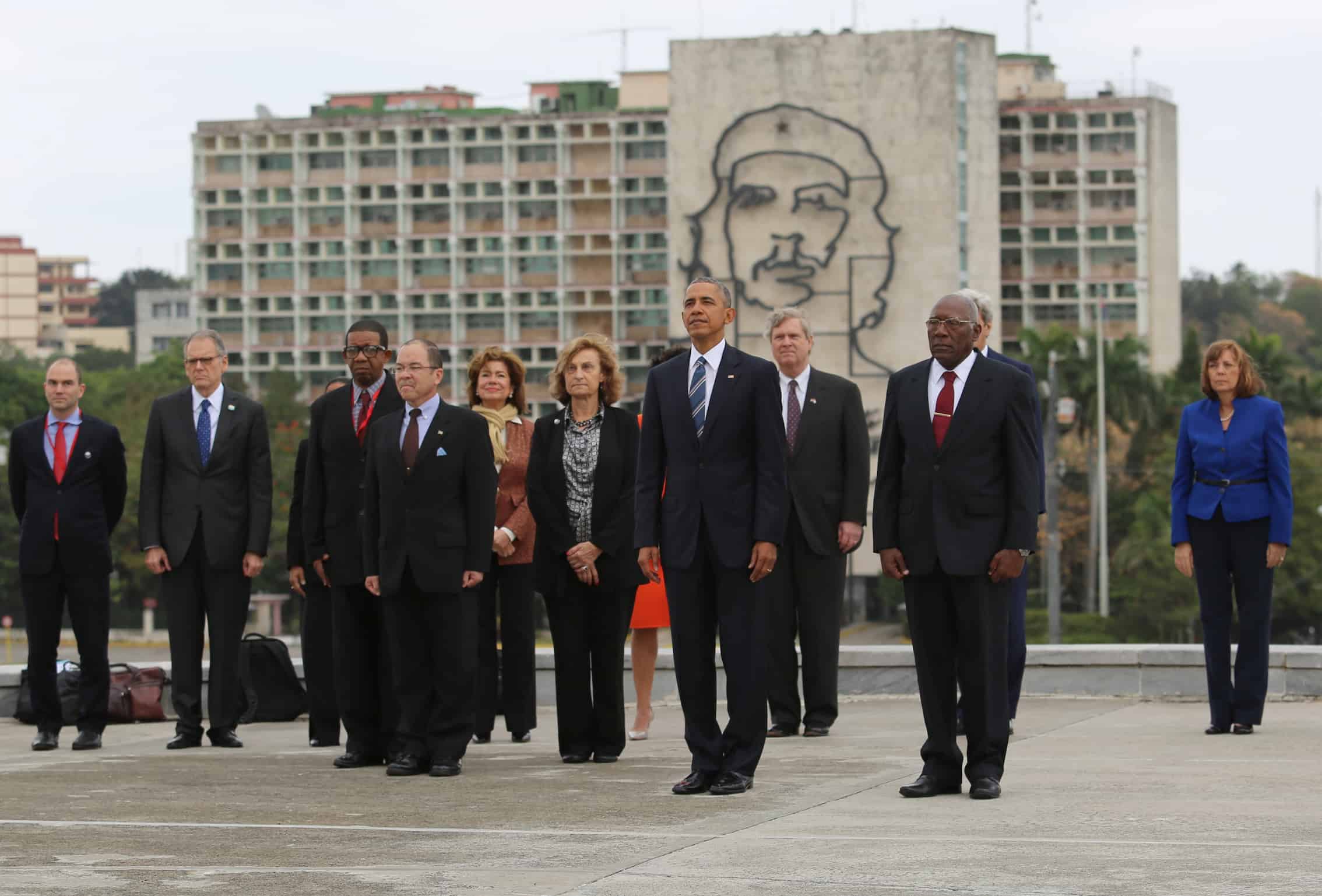Earlier, Obama stopped at the nearby Plaza of the Revolution, where he laid a wreath at the massive statue of 19th century independence hero José Martí, who gazes pensively down at the place where Fidel Castro later delivered stem-winding speeches denouncing U.S. imperialism.
Immediately after the wreath-laying, Obama was mobbed by Cuban and U.S. television reporters standing in the plaza. As he chatted, Secretary of State John Kerry and national security adviser Susan Rice hovered outside the media scrum before a smiling Obama made his way back into his security bubble.
He walked, through a stiff breeze under cloudy tropical skies, to the nearby palace. After the official greeting, the two leaders headed to a palm-filled meeting room, where they engaged in animated chatter, through an interpreter, before the doors were closed for what was scheduled to be a two-hour conversation. Later, they will deliver statements at a public appearance together.
Unless the Cubans have a change of heart, there will be no joint news conference, despite a last-minute trip here last Friday by Ben Rhodes, Obama’s deputy national security adviser, to press the matter.
Obama’s schedule has taken him into the heart of Cuban government power, where no U.S. president has been before. The Martí monument is in a place as central to modern Cuban history as Moscow’s Red Square is to Russia’s. Over the decades, Soviet tanks and missiles rolled through during military parades, past the giant murals of fallen revolutionary heroes Ernesto “Che”Guevara and Camilo Cienfuegos. Cuban government workers and students still dutifully file through every May Day.
The palace houses the offices of the Cuban president. It is a building that was almost surely targeted for annihilation during the Cuban Missile Crisis of October 1962, and long after that.
Later Monday, Obama will participate in a meeting between U.S. business and Cuban entrepreneurs, held at a cavernous beer brewery along the waterfront of Havana Bay.
The place has a clear view of the former Texaco oil refinery, nationalized by the Castro government when its managers refused to process the first shipments of Soviet crude in 1960, setting off a tit-for-tat that ended with the 1960 embargo that Obama now seeks to lift.
It was there, in Havana Harbor, where the USS Maine exploded in 1898, launching an American invasion of Spanish-occupied Cuba and the Spanish-American War that briefly turned the island into a U.S. possession.
In the evening, Obama will return to the palace for a state dinner hosted by Raúl Castro.
On Sunday, rain that started as soon as Air Force One touched down at José Martí International Airport complicated plans for the first family. But Obama, first lady Michelle Obama and their daughters plunged ahead, under umbrellas, with an evening tour of Old Havana. They later dined in a paladar, one of the privately owned restaurants the administration is promoting on a trip that is part traditional diplomacy and capitalist boosterism.
Speaking to staff members at the U.S. Embassy on Sunday evening, Obama made a point of saying that the children who attended the session embodied the kind of generational shift he hopes will happen in the United States and Cuba in the years to come.
“That’s the future that we hope for — young American children, young Cuban children, by the time they’re adults, our hope is that they think it’s natural that a U.S. president should be visiting Cuba, they think it’s natural that the two peoples are working together,” he said.
But in the continuing political battles Obama left at home, Republicans who have questioned his rapprochement with Cuba were quick to criticize the trip.
Sen. Ted Cruz, Texas, a Cuban-American and one of the top contenders for the GOP presidential nomination this year, wrote in Politico magazine that Obama’s approach is contrary to the strategy that presidents such as Ronald Reagan used to topple dictatorial regimes.
“This is why it is so sad, and so injurious to our future as well as Cuba’s, that Obama has chosen to legitimize the corrupt and oppressive Castro regime with his presence on the island,” Cruz wrote.
GOP front-runner Donald Trump, who has said he is “fine” with closer Cuba ties, questioned why Castro was not at the airport for Obama’s arrival. “Wow, President Obama just landed in Cuba, a big deal, and Raul Castro wasn’t even there to greet him,” Trump tweeted Sunday. “He greeted Pope and others. No respect.”
Although it is not normal diplomatic practice for state visits in most of the world, Castro greeted Pope Francis at the Havana airport when the pontiff made his first visit here in September, just as Obama did when Francis came to Washington days later.
Cuban television has covered much of Obama’s visit here live, and news of his arrival was at the top of the website of Granma, the Communist Party paper. In Old Havana, Cubans from the neighborhood and others allowed inside tight security chanted “USA” and cheered him.
On Tuesday, Obama will deliver a 40-minute address to the Cuban people, held at the National Theater and expected to be broadcast live here. Later that morning, one of the most tense moments of the visit will come when he is scheduled to hold a private meeting at the embassy with about a dozen of Cuba’s most prominent political dissidents.
Video: Obama and Castro meet in Cuba
© 2016, The Washington Post






